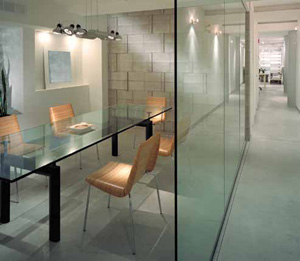Back At The Office

Designing An Effective Work Environment
It used to be that ping-pong, pool tables and flextime were considered the perks of a hip workplace. These days, pool and ping-pong may be out of style, but flexibility is more crucial than ever. Not only are employees adjusting the hours during which they perform their functions, the way they are doing their jobs has changed as well.
This means that the central work environment needs to be set up to support this flexibility. Diane Stegmeier, president of the Cleveland, OH-based firm Stegmeier Consulting Group, a company that partners with architects and designers, noted that her research indicates that employees are working anywhere but their dedicated work spaces 63 percent of the time. Instead, they’re crossing off their to-dos in other buildings on the corporate campus, from airport lounges, in hotel rooms… or even at the local coffee shop. This mobility requires “head office” to be elastic, in a sense.
Steigmeier, author of Innovations in Office Design: The Critical Influence Approach to Effective Work Environments, illustrated, “This physical container of a traditional office environment is intended to shelter and hold employees while they do their work. Unfortunately, that box is a constrained space that’s composed of inflexible walls, and it actually stifles the work performance.” The workplace, she added, should shrink and grow in conjunction with the workforce and workplace needs.
On a practical level, creating flexibility at the office can be quite simple: the purchase of furniture and equipment on wheels makes moving things around extremely easy. “In prior days, elements tended to be fixed: the cubicle walls were fixed and the end user did not change that,” Steigmeier said. Now, employees can alter the level of privacy required by pushing office elements in—or out—of the way. “An open environment makes the office very user-centric.”
In this economic climate, business leaders may be reticent to invest in something that, in many cases, may be viewed as redecorating. Stegmeier, however, noted that while modifying workplace design may require a bit of an investment, it can be even more expensive not to do anything at all. Her 10-year study that surveyed 140 companies in 24 industries across North America and Western Europe showed that an individual workspace costs organizations an average of between $8,000 to $14,000 (U.S.) annually, taking into consideration rent, operations, and depreciation— even if they’re not being fully used. “There are already many work stations sitting vacant because companies have down-sized, so there is already excess real estate,” she said. Implementing an “alternative workspace strategy” or “shared office environment” can cut these costs significantly. “This is designed to support the actual utilization of space and the existing or planned mobility for the workforce.”
Just because the office is “shared” doesn’t mean that privacy is compromised; it’s how you obtain it that changes. Employees may reserve private offices or team briefing rooms when necessary, and work out in the open the rest of the time. The office may feature “touchdown” spaces where employees can quickly check email and respond to messages, and desks may be attributed on a firstcome, first-served basis. Basically, it’s up to staff members to determine what environment-within-the-environment is best-suited for the goals they intend to achieve on any given day—and the dollars saved from eliminating excess real estate can be earmarked for things like technology that supports an increasingly mobile workforce.
A daily selection of the top stories for AV integrators, resellers and consultants. Sign up below.
AVYVE, a systems integration firm based in Norcross, GA, features a “client experience center” that serves as a demonstration space for customers that are designing their own work environments. This facility is equipped with a boardroom, conference space, client briefing facility, and collaboration room to show what technology can be taken advantage of to streamline efficiencies. AVYVE’s own team—which recently completed a project that included the implementation of a shared office environment for Coca-Cola Enterprises—also practices what it preaches: “You don’t have a specific desk, and nor do I,” explained Merry S. McCleary, AVYVE’s president and CEO. “We walk in and choose that spot that we think is going to be effective for the work that we’re doing today. That may be banquette seating in the café; it can be a headsdown spot in a corner because we need to focus, or it could be a touchdown space that’s near a window.”
For Darren Cheshier, engineer at SKC Communication Products, a systems integration firm in Kansas City, KS, striking the balance between privacy and open communication is essential. “You don’t want to be talking on the phone and not hear anything because everyone else is talking on the phone, too,” he said. At SKC, a sound-masking system minimizes this issue. He adds that in his three years at SKC he’s moved three different times, and that it’s part of the organization’s policy to keep things mobile. “All of the cubes are the same size and they’re laid out in approximately the same way, so it’s easy for people to move around. We’re told: Don’t make it too hard to move, so if we’re working on a large project, we may move around to put certain teams together.”
Ultimately, Steigmeier emphasized, it all comes back to the concept of flexibility. “An effective workplace is one that adapts to the increasingly mobile workforce—not the other way around,” she said. “The workplace is what needs to adapt, change, and be flexible.”
Carolyn Heinze is a freelance writer/ editor.
MARGIN BUILDER
With employees on-the-go, it’s increasingly important to find effective ways of keeping them informed. Darren Cheshier, engineer at SKC Communication Products in Kansas City, KS, suggests that in-house digital signage systems make it easy to distribute internal messages. “Being able to communicate internally, to the masses, is important,” he said. “With digital signage, you can announce special company events, or even applicable news items that may be on TV.” With everyone moving around, this element can assist in making the workplace more united.
Carolyn Heinze has covered everything from AV/IT and business to cowboys and cowgirls ... and the horses they love. She was the Paris contributing editor for the pan-European site Running in Heels, providing news and views on fashion, culture, and the arts for her column, “France in Your Pants.” She has also contributed critiques of foreign cinema and French politics for the politico-literary site, The New Vulgate.
